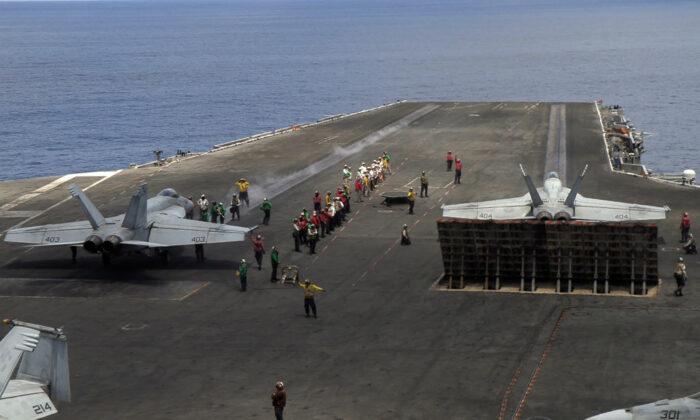The Pentagon said Beijing has further destabilized the situation in the South China Sea, after it test-launched ballistic missiles during military exercises in the contested waters.
The Pentagon statement said Beijing fired these missiles around the Paracel Islands, a disputed archipelago in the region, while conducting exercises, but did not specify which date, how many had been fired, or the types of missiles.
China’s People’s Liberation Army (PLA) is conducting exercises in the South China Sea from Aug. 23 to 29.
“This military exercise is the latest in a long string of PRC [People’s Republic of China] actions to assert unlawful maritime claims and disadvantage its Southeast Asian neighbors in the South China Sea,” the Pentagon said.
The Chinese regime has amped up its aggression in the region as the United States has simultaneously sought to counter its threats.
Islands, reefs, and rocks in the strategic waterway are claimed by a number of countries, including Brunei, China, Malaysia, the Philippines, Taiwan, and Vietnam.
Beijing has used the “nine-dash line” to proclaim sovereignty over 90 percent of the South China Sea, despite a United Nations legal judgment in 2016 that refuted Beijing’s claims.
Chinese Missiles
On Thursday, Japanese media NHK reported that China fired four ballistic missiles toward the South China Sea on Wednesday, citing unnamed U.S. military sources. NHK stated the missiles fell between China’s island province of Hainan and Paracel Islands.Chinese officials have kept mum about the missile launches. Asked about the Pentagon’s statement during a daily briefing on Friday afternoon, China’s Foreign Ministry spokesperson Zhao Lijian did not comment on the launches but accused the United States of being the “destroyer and troublemaker” of stability in the South China Sea.
Military Exercises
Concurrently, Beijing is conducting military drills in three other waterways near China: the Bohai Sea, the Yellow Sea, and the East China Sea.“We continually organized the combat drills in the Taiwan straits targeting foreign forces, targeting the Taiwan independence separatist forces,” Wu claimed.
Beijing claims Taiwan as part of its territory despite it being a self-ruled island with its own democratically-elected government, military, and currency. The United States has continually sailed its military vessels near Taiwan, in addition to selling arms, to assist the island in defending against Beijing’s military provocations.
In the past, the Chinese regime has used similar language to accuse the United States of supporting a split between the mainland and Taiwan. On Aug. 10, China’s hawkish state-run media Global Times ran an editorial that said the U.S. was using Taiwan “as its pawn to contain the Chinese mainland.”
On Aug. 13, Global Times published an article saying that China’s military drills in the Taiwan straits were aimed at deterring “the provocative and dangerous connection between the island [Taiwan] and the U.S.”
US Plane
This week, the Chinese regime also accused the United States of “trespassing” its no-fly zone when a U-2 reconnaissance plane flew over combat drills in the Bohai Sea.Wu called the U-2 flight a “provocative” action during an Aug. 25 press conference.
The U.S. Pacific Air Forces, in a statement to CNN, stated the U-2 flight “was conducted in the Indo-Pacific area of operations and within the accepted international rules and regulations governing aircraft flights.”
The day prior, a RC-135 reconnaissance aircraft had entered the South China Sea via the same channel. And on Tuesday, a Challenger 650 reconnaissance aircraft also passed through the same area, according to Chinese officials.
U.S.-based China affairs commentator Tang Jingyuan said despite Beijing’s recent show of muscle and rhetoric, the Chinese regime is not prepared for war.
Reactions
Several nations voiced concerns over China’s actions. According to Japanese newspaper Mainichi, Japan’s Chief Cabinet Secretary Yoshihide Suga, in response to a question about China’s missile launches at a press conference on Thursday, stated: “Our country is strongly opposed to whatever act that heightens tensions in the South China Sea.”“We will continue to conduct multilateral exercises and freedom of navigation operations in the Indo-Pacific waters & will not be intimidated by China’s growing aggression,” Blackburn said.
“It is crucial that U.S. investors and businesses are aware that PRC companies involved in the militarization of the South China Sea maintain a presence in our capital markets,” Risch stated.






